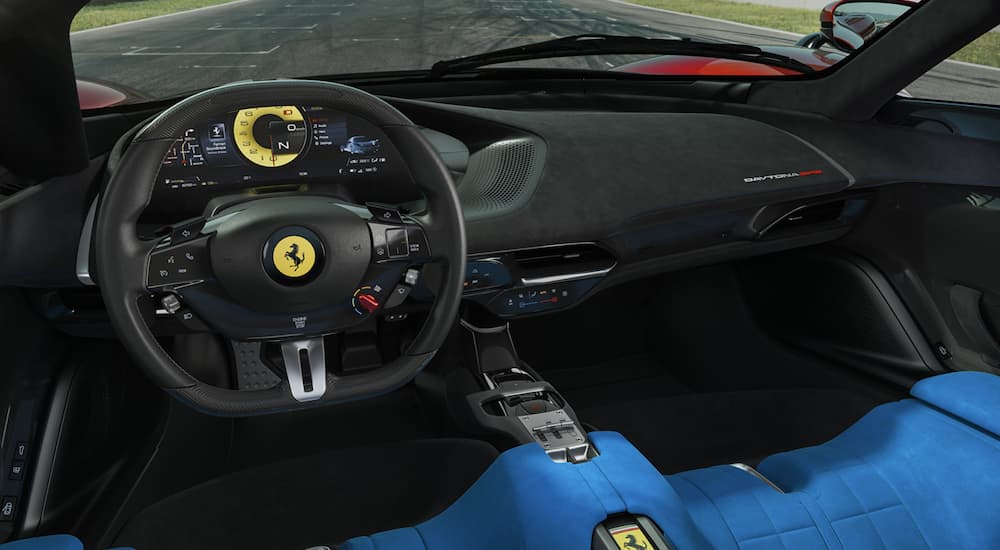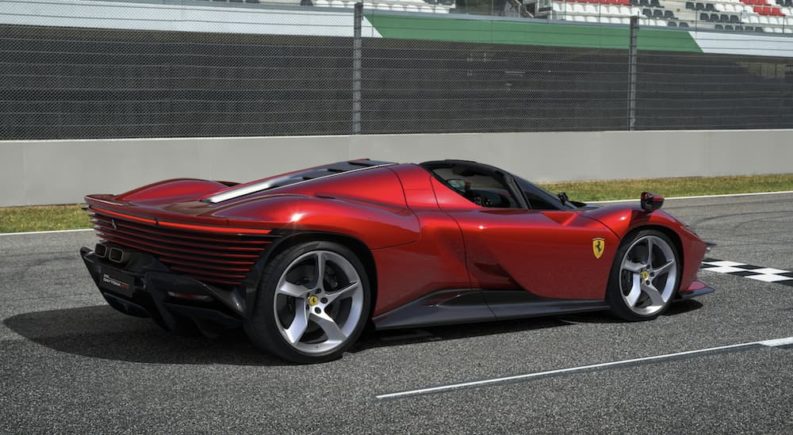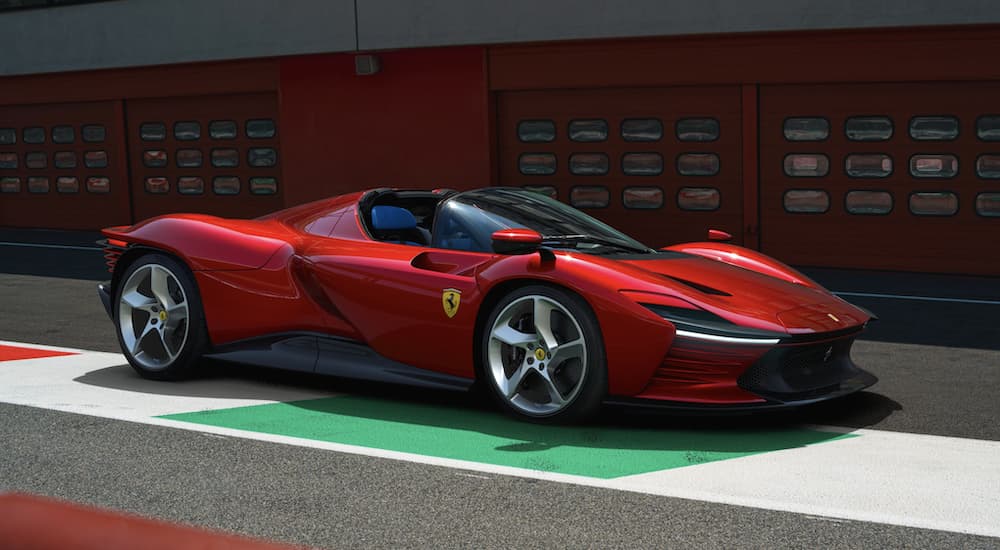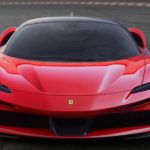You’re not really sure when it began, but it doesn’t matter. You’re here now, watching it, living it, being the excitement. They’re gaining fast, right on your tail, but through sheer will you cut them off, take them out, pull away. Your first-person view transitions seamlessly to the grandstands, uncompromised by netting or fence posts, and as the leader comes careening into view for the final straight, time stands still. The brilliant crimson Ferrari lingers, almost on pause, allowing you to soak in every wonderful detail—then, with a hair-raising yowl, it flashes past. Your head snaps around to follow the screaming blur, and you wake with a start.
Maybe you’re lying in bed, with a suddenly awful crick in your neck. Perhaps it was a daydream, and you’ve come around in the lunchroom, at your office, or by the side of the road to the amusement of your peers. You might be assembling a model, or even playing with one, be it Lego bricks, hand-painted, or remote-controlled. It’s a form of excitement, an object of admiration, that unites people of every age, creed, and nation, whether they adore the automobile or don’t know a 911 from a Beetle—it’s the name those people will use when they ask what kind of car that was, because they know it was special.
Everything Ferrari does just hits differently. They’re virtually the only manufacturer in the world who sells cars on Monday to race them on Sunday and not the other way around—and by far the most enduring and successful at it. They were there at the dawn of F1, and they’ll still be there at dusk, shooting through the twilight with inescapable voracity. The legend that backs up the brand goes back to the 1940s, when Enzo Ferrari broke away from Alfa Romeo and began to engineer his own race cars, finally able to put his own name to it in 1947. Countless on-track victories in the decades since have created countless memories and an anthology that other makers simply don’t have, at least not to such an extent, attracting fans of all sorts to the brand.
They’re almost playing on easy mode at this point, because nearly anything they create will be met with widespread excitement, and anything they do beyond the bare minimum will be met with wild acclaim (I say almost, because to design, engineer, and build some of the most comprehensively excellent sports cars in the world will never be easy). As a case study, consider the instantly sold-out Icona series cars—ridiculously expensive, incredibly rare, and even more exclusive, positioned between supercar and hypercar, with their value almost entirely based on the iconic racing cars that inspired them from Ferrari’s many glory days.

Instant Icons of Their Own
The Icona series is relatively new, with only two distinct models: the Monza SP and Daytona SP3. The Monza SP1 and SP2, hilariously impractical barchettas with literally no windshield at all and numbered according to how many seats they have, sold for nearly $2 million each to an exclusive list of 499 unfathomably wealthy friends of the brand. But the latest news is the first Ferrari to genuinely bear the Daytona name: the Daytona SP3 (selling at nearly $2.5 million a piece to 599 Ferrari insiders without a second thoughtF, reportedly including every Monza SP owner).
We’ll get to its story in a second, but first, just bask in what the Daytona SP3 is: the LaFerrari platform, squished out a little, put through a blender with the future, the past, and the now, and stuffed with the most powerful naturally-aspirated V12 that Ferrari ever built. It makes 829 prancing horses that sing all the way up to a choral howl at 9500 rpm. Huge wheel fenders and a wraparound windshield are stylized after the 1967 race cars, which earned the brand-new 1968 365 GTB/4 the “Daytona” nickname. The interior’s over-the-tunnel fabric coverage is a 1960s throwback as well.
Huge, beautifully shaped body panels uninterrupted by fitment gaps help to manage airflow so the car can generate downforce at speed without using an unsightly wing. A driver-centric interior, with most controls on the wheel and a fully digital dash display, will be familiar to the Daytona’s lucky buyers as it’s a carbon copy from the SF90. Back on the outside, unique individual carbon-fiber strakes stretch across the rear vent deliver major Testarossa vibes.
This is the latest stylistic showcase from Ferrari; it is a sight and sound to behold, an event that squeezes itself into any busy schedule it should come across. One does not simply ignore the Daytona SP3, which likely counts itself among the last naturally-aspirated V12-powered vehicles ever made, merely adding to its intrigue. A car that is all at once the last, greatest, rarest, noisiest, and most beautiful of its kind—even Ferrari will be hard-pressed to outdo themselves should the Icona series continue.
But that isn’t all that makes the Daytona SP3 special. The legend that inspired it is a story for the ages as well.
The Grandest Heritage
1966 was a transformative year for Ferrari. Racing buffs didn’t need the film Ford v. Ferrari to spell it out back in 2019, but hey, now everyone else knows the gist of the story, too. The movie spins it as a sales-related move (which it undoubtedly was), but rumors persist that Ferrari’s majority sale to Fiat in 1963—directly undercutting an offer from Ford—was what sparked a vengeful rage in Henry Ford II, vowing to knock Ferrari off their high horse of dominance at Le Mans.
The Ford GT40 decisively unseated Ferrari in 1966, with an iconic 1-2-3 simultaneous finish, while no prototype-class Ferraris finished the race at all—Lorenzo Bandini’s 330 P3 was the last to go, blowing its engine after 17 hours and 226 laps. Ferrari’s best finish was 35 laps behind the 3rd place GT40. The American upstart had thrown down the king.
So that was 1966. Even with all that, I wouldn’t say it was a bad year, just transformative. Ferrari’s loss in 1966 was about their own failure every bit as much as it was about Ford’s success, and Enzo set his team hard to the task of learning from it. An in-house 5-speed replaced the chronically failing Tipo 593 ZF gearbox, and the thoroughly-overhauled engine included Ferrari’s first 3-valve-per-cylinder design, a relocated fuel injection system for efficiency and F1-derived cylinder heads. The 330 P4 that resulted was more powerful and, critically, more reliable than its predecessor.
A dramatic lead-up to the 1967 season included development on a budget, testing in front of public spectators at Daytona, a command not to break the Daytona lap record that was ignored (thus putting Ford on notice before the race), major shake-ups in personnel on either side, and more. Then, the season-opening 24 Hours of Daytona saw a trio of 330 P4s (including a converted P3, known as the P4 Spyder) pitted against 6 GT40 Mk.IIs. Cobbled together after the hazardous Ford “J” prototype failed to develop in time, they included new 7 L engines and transmissions, which would ultimately be their downfall.
The race, lovingly documented by Sports Car Digest, saw Ford after Ford hit the pits to replace transmissions, until eventually no spares remained and all but one of the Mk.IIs retired, the sole survivor finishing 300 miles behind the leaders with a blown head gasket forcing repeated pit stops. A radical Chaparral with a comic wing set a blistering pace to start the day, but as the Fords pushed themselves to their ultimate demise to keep up with it, Ferrari maintained a steady pace, trusting their ability to sustain and make up ground—as long as they didn’t fall too far behind.
Dangerously transient track conditions led the Chaparral’s second driver to lose control and crash, ultimately knocking them out of the race only 4 hours in, and with the Fords already dropping like flies, Ferrari took control and never lost it. They held positions 1-4 by the 6th hour, and by hour 18 they let up the pace as only the straggling, constantly overheating Ford remained to challenge them. They drafted each other to save fuel, and took to preserving their vehicles in favor of stretching what was a 19-lap lead over 4th place by the end.
In the final moments, taking a V-formation sitting 3-wide across the track, the Ferraris forced everyone else down to their easy pace. They ensured that at the finish, all eyes would be fixed on the victors from Scuderia Ferrari. As they did, the drivers revved their engines high, making 36 cylinders proudly declare the triumphant return-to-form of the greatest racing marque of all time.
Though they did not race at Sebring, and did not win against the much faster GT40 Mk.IVs at Le Mans (taking second and third instead), following Daytona the 330 P4s were consistently good enough to take back the world championship, finishing their mission. This was important but besides the point—coming back in the very next major race and demolishing Ford so completely on their “home turf” is what earned the Daytona nickname for Ferrari’s forthcoming grand tourer. The competitive revenge could not have been more cathartic; a painting of the 330 P4s crossing the line in formation held a place of honor in Enzo’s office until his death in 1988.
A Legend for Everyone
The flip side of the awesome story captured by 2019’s Ford v. Ferrari is a tale every bit as intriguing and engaging—so were any of them actually good guys / bad guys, or were they all just really freakin’ competitive? I’ll lean towards the latter, but ultimately, this is just one of countless Ferrari legends. Virtually every year from 1947 onwards brings a new Ferrari story that could enthrall a million new fans; this just happens to be the one that inspired the Icona Series’ Daytona SP3.
And why shouldn’t Ferrari have a story for every racing fan to love? The only manufacturer to participate in F1 from its inception, virtually the only racing house that sells cars just to fund the racing division, Ferrari is the manifestation of passion. Though Rossa Corsa is officially the Italian racing color, it’s inextricable from Ferrari’s identity; the yellow shield and prancing horse on a blazing red backdrop is recognizable around the world.
The significance behind their cars goes deeper than simply pushing the limits of mechanical possibility. As the Daytona SP3 demonstrates, Ferrari touches upon something in the deepest parts of our souls, stirring excitement over a car none of us are ever likely to see in person, never mind own.
But for the rest of us, at least there’s the Lego Technik version, right? If you’re into that sort of thing, hours of assembly await as nearly 4000 pieces come together to create a shockingly accurate replica of the limited-edition targa top. I mean, it’s got a functioning gearbox! What!? It’s not exactly a cheap piece, but far more attainable than a gas-powered Ferrari.





